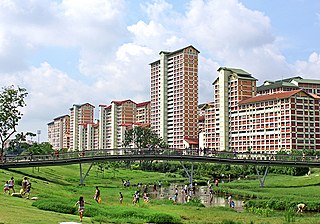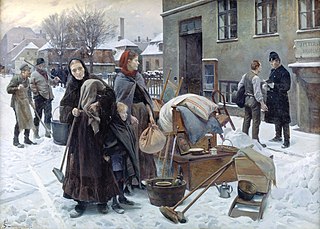
Southfield is a city in Oakland County in the U.S. state of Michigan. An inner-ring suburb of Detroit, Southfield borders Detroit to the north, lying roughly 15 miles (24.1 km) northwest of downtown Detroit. As of the 2020 census, the city had a population of 76,618.

Public housing is a form of housing tenure in which the property is usually owned by a government authority, either central or local. Although the common goal of public housing is to provide affordable housing, the details, terminology, definitions of poverty, and other criteria for allocation vary within different contexts.

Corktown is a neighborhood located in Detroit, Michigan. It is the oldest extant neighborhood in the city. The current boundaries of the district include I-75 to the north, the Lodge Freeway to the east, Bagley and Porter streets to the south, and Rosa Parks Boulevard to the west. The neighborhood was listed on the National Register of Historic Places in 1978.

Eviction is the removal of a tenant from rental property by the landlord. In some jurisdictions it may also involve the removal of persons from premises that were foreclosed by a mortgagee.
Subsidized housing is government sponsored economic assistance aimed towards alleviating housing costs and expenses for impoverished people with low to moderate incomes. In the United States, subsidized housing is often called "affordable housing". Forms of subsidies include direct housing subsidies, non-profit housing, public housing, rent supplements/vouchers, and some forms of co-operative and private sector housing. According to some sources, increasing access to housing may contribute to lower poverty rates.

Midtown Detroit is a commercial and residential district located along the east and west side of Woodward Avenue, north of Downtown Detroit, and south of the New Center area. The area includes several historic districts. In addition, it contains a residential area of some 14,550 people and covers 2.09 sq mi. The community area of neighborhoods is bounded by the Chrysler Freeway (I-75) on the east, the Lodge Freeway (M-10) on the west, the Edsel Ford Freeway (I-94) on the north, and the Fisher Freeway (I-75) on the south.

New Center is a commercial and residential district located in Detroit, Michigan, adjacent to Midtown, one mile (1.6 km) north of the Cultural Center, and approximately three miles (5 km) north of Downtown. The area is centered just west of the intersection of Woodward Avenue and Grand Boulevard, and is bounded by, and includes the Virginia Park Historic District on the north, the Edsel Ford Freeway (I-94) on the south, John R Street on the east and the Lodge Freeway on the west. New Center, and the surrounding areas north of I-94, are sometimes seen as coterminous with the North End, while in fact separate districts.

Public housing in Australia is one part of social housing and the other is community housing. Public housing is provided by departments of state governments. Australian public housing operates within the framework of the Commonwealth-State Housing Agreement, by which funding for public and community housing is provided by both federal and state governments. According to the 2006 census, Australia's public housing stock consisted of some 304,000 dwellings out of a total housing stock of more than 7.1 million dwellings, or 4.2% of all housing stock.

In the United States, subsidized housing is administered by federal, state and local agencies to provide subsidized rental assistance for low-income households. Public housing is priced much below the market rate, allowing people to live in more convenient locations rather than move away from the city in search of lower rents. In most federally-funded rental assistance programs, the tenants' monthly rent is set at 30% of their household income. Now increasingly provided in a variety of settings and formats, originally public housing in the U.S. consisted primarily of one or more concentrated blocks of low-rise and/or high-rise apartment buildings. These complexes are operated by state and local housing authorities which are authorized and funded by the United States Department of Housing and Urban Development (HUD). In 2020, there were one million public housing units. In 2022, about 5.2 million American households that received some form of federal rental assistance.

Cass Community Social Services, Inc. is a nonprofit, 501(c)(3) community-based organization headquartered in Detroit, Michigan, serving Southeastern Michigan, Wayne County, under the direction of a volunteer Board of Directors. Cass Community Social Services has occasionally engaged In acts of political activism, usually In protest of city and state budget cuts.

The tiny-house movement is an architectural and social movement promoting the reduction and simplification of living spaces. According to the 2018 International Residential Code Appendix Q, a tiny house is defined as 'a home with a maximum floor area of 37 m2, excluding lofts.' Often called with 'micro-house,' this movement is associated with cost-effective and simple living. Proponents suggest it could offer eco-friendly alternatives within the housing market and serve as a transitional housing option for homeless individuals. People join the movement for various reasons, including minimizing waste and reducing living expenses.

The University–Cultural Center MRA is a pair of multiple property submissions to the National Register of Historic Places which were approved on April 29 and May 1, 1986. The structures included are all located in Midtown, near Woodward Avenue and Wayne State University in Detroit, Michigan. The two submissions are designated the University–Cultural Center MRA Phase I, containing five properties, and the University–Cultural Center MRA Phase II, containing three properties.

The Cass Farm MPS is a US multiple property submission to the National Register of Historic Places which was approved on December 1, 1997. The structures included are all located in Midtown, in the Cass Farm area in Detroit, Michigan, USA. The Cass Farm area is defined as occupying the space between Woodward Avenue on the east, the Lodge Freeway on the west, Warren Avenue on the north, and Martin Luther King Jr. Boulevard on the south.

Public housing in the United Kingdom, also known as council housing or social housing, provided the majority of rented accommodation until 2011 when the number of households in private rental housing surpassed the number in social housing. Dwellings built for public or social housing use are built by or for local authorities and known as council houses. Since the 1980s non-profit housing associations became more important and subsequently the term "social housing" became widely used, as technically council housing only refers to housing owned by a local authority, though the terms are largely used interchangeably.
Housing and Community Development Act of 1992 was first introduced to the 102nd Congress on June 5, 1992, and was signed and made law by President George H. W. Bush on October 28, 1992. Also known as "The 1992 Act", the bill amended a number of housing, banking, and drug abuse laws. It amended The United States Housing Act of 1937. It increased aggregate budget authority for low-income housing for fiscal year 1993 and 1994. It also extends ceiling rents, excludes certain child care expenses, and excessive travel expenses from the calculation of adjusted income and apply to Indian public housing certain definitions of the Cranston-Gonzales National Affordable Housing Act; It allows the Secretary of Housing and Urban Development to issue public and Section 8 housing tenant preference rules. The Act also extends certain exemptions from waiting list requirements and eligibility restrictions with respect to income eligibility for assisted housing and while revising the family self-sufficiency program, with respect to escrow saving accounts, incentives for participation, and action plans.
Alternative housing is a category of domicile structures that are built or designed outside of the mainstream norm e.g., town homes, single family homes and apartment complexes. In modern days, alternative housing commonly takes the form of tiny houses, dome homes, pyramid-shaped houses, earth sheltered homes, residential tree houses, abandoned factories and hospitals and even up-cycled vans or buses. The motivation to create alternative homes can arise from destitution or lack of resources to buy or rent a typical home and therefore include improvised shacks in shantytowns, buses, cars and tent-like structures.

Eviction in the United States refers to the pattern of tenant removal by landlords in the United States. In an eviction process, landlords forcibly remove tenants from their place of residence and reclaim the property. Landlords may decide to evict tenants who have failed to pay rent, violated lease terms, or possess an expired lease. Landlords may also choose not to renew a tenant's lease, however, this does not constitute an eviction. In the United States, eviction procedures, landlord rights, and tenant protections vary by state and locality. Historically, the United States has seen changes in domestic eviction rates during periods of major socio-political and economic turmoil—including the Great Depression, the 2008 Recession, and the COVID-19 pandemic. High eviction rates are driven by affordable housing shortages and rising housing costs. Across the United States, low-income and disadvantaged neighborhoods have disproportionately higher eviction rates. Certain demographics—including low income renters, Black and Hispanic renters, women, and people with children—are also at a greater risk of eviction. Additionally, eviction filings remain on renters' public records. This can make it more difficult for renters to access future housing, since most landlords will not rent to a tenant with a history of eviction. Eviction and housing instability are also linked to many negative health and life outcomes, including homelessness, poverty, and poor mental and physical health.

Juanita Nielsen's House is the heritage-listed former house of murdered activist and journalist Juanita Nielsen at 202 Victoria Street in the inner city Sydney suburb of Potts Point in the City of Sydney local government area of New South Wales, Australia. It was built from 1855 and designed in the Federation filigree. It was added to the New South Wales State Heritage Register on 27 June 2014.

Affordable housing is housing that is deemed affordable to those with a median household income as rated by the national government or a local government by a recognized housing affordability index. A general rule is no more than 30% of gross monthly income should be spent on housing, to be considered affordable as the challenges of promoting affordable housing varies by location.
Faith Fowler is an American pastor and community activist. She is the senior pastor of Cass Community United Methodist Church and the executive director of Cass Community Social Services (CCSS), a large nonprofit in Detroit that serves more than 700,000 meals a year and houses about 300 homeless people per night alongside a day program, medical clinics, and a job center. CCSS was established as a nonprofit 501(c)(3) in 2002. Prior to that, many of its programs started as a part of Cass Community United Methodist Church.

















